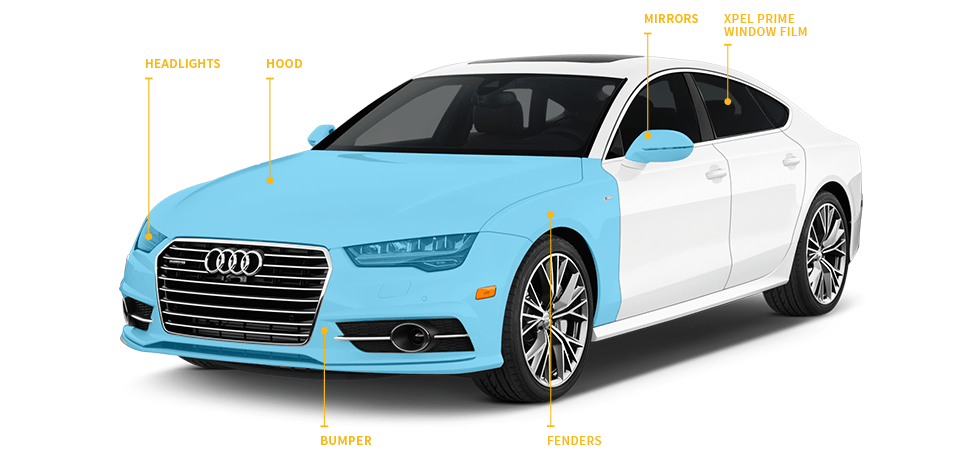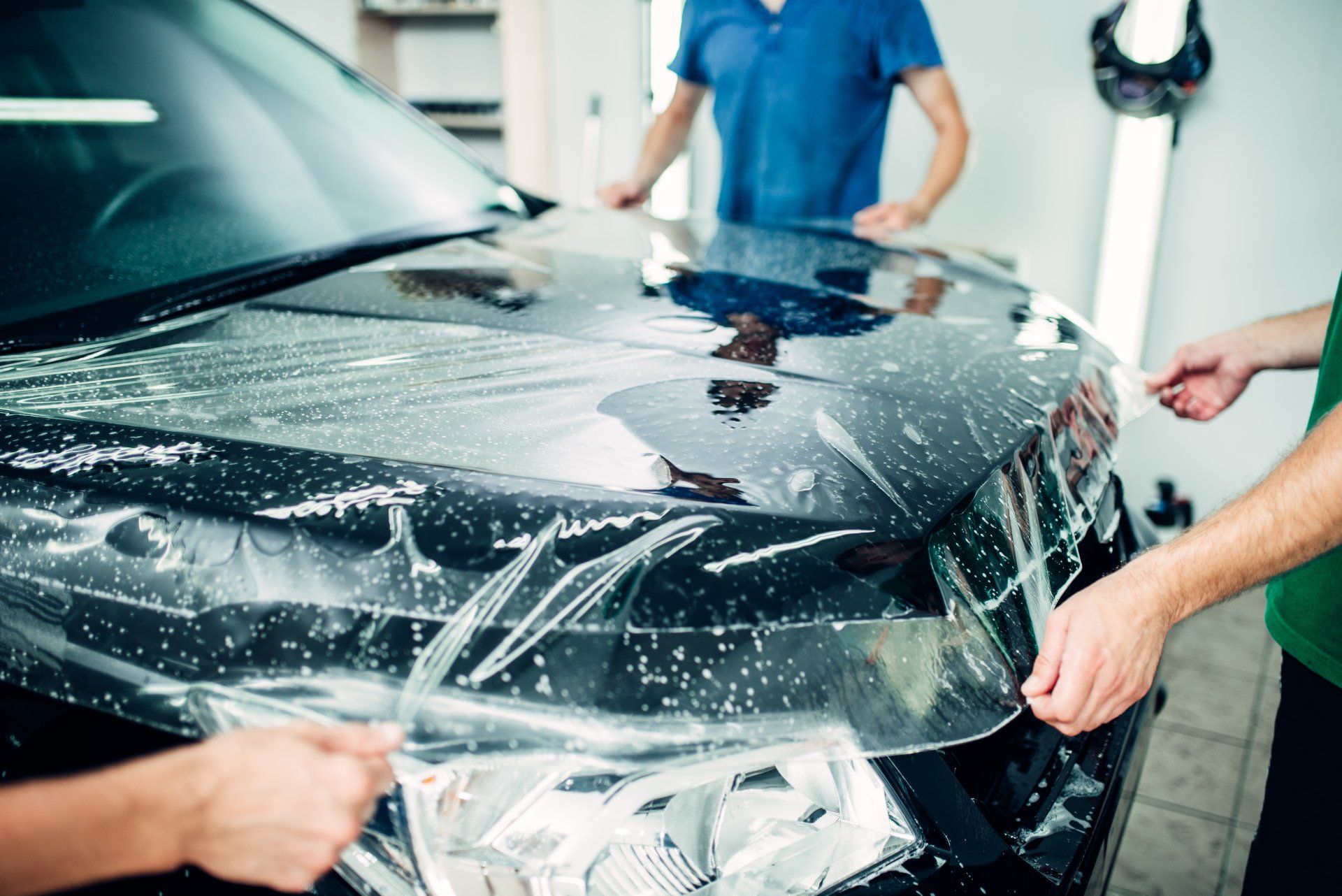Top reasons to invest in SpeedEFX Paint Protection Film for your favorite car
The Ultimate Guide to Understanding Paint Protection Film for Car Fanatics
Paint Protection Film (PPF) has come to be a vital subject among automobile enthusiasts looking for to keep their automobile's look. This sophisticated safety layer provides countless benefits, from securing against environmental threats to preserving resale worth. Understanding the different kinds of PPF, the application process, and maintenance pointers can significantly influence one's financial investment. Many mistaken beliefs linger. What are the most common myths, and just how do they contrast to other protective alternatives?
What Is Paint Protection Film (PPF)?
Paint Protection Film (PPF) works as a clear shield for automobile surface areas. This innovative polyurethane material is developed to adhere effortlessly to a lorry's exterior, offering a protective layer versus numerous ecological threats. PPF is commonly related to high-impact locations, such as hoods, bumpers, and mirrors, where scrapes and chips are most likely to occur.The film is incredibly long lasting, supplying resistance versus UV rays, roadway particles, and chemical discolorations, which can degrade a car's surface gradually. Its self-healing residential or commercial properties enable minor scratches to disappear with heat exposure, preserving an immaculate appearance. PPF is available in various finishes, consisting of gloss and matte, to match various paint designs and preferences.Installation calls for accuracy, commonly best done by specialists to ensure a perfect application. Generally, Paint Protection Film is a cutting-edge option for auto fanatics looking for to protect their car's aesthetic appeal while shielding its surface area stability.
Benefits of Making Use Of Paint Protection Film
While numerous car fanatics prioritize visual appeals, the practical benefits of Paint Protection Film (PPF) are just as engaging. PPF works as a durable barrier against numerous ecological dangers, consisting of roadway debris, stone chips, and insect spots, effectively maintaining the car's exterior. Furthermore, it offers UV protection, protecting against paint from fading and preserving the automobile's vibrant color over time.Another significant benefit is the self-healing residential properties of sophisticated PPFs, which can recoup from minor scratches and swirl marks with heat exposure, ensuring the coating stays beautiful. Installation of PPF can likewise boost resale worth; prospective customers are typically brought in to well-maintained cars without any noticeable imperfections. PPF is easy to clean and needs very little upkeep, enabling car enthusiasts to enjoy their automobiles without the stress and anxiety of consistent maintenance. Overall, PPF combines performance with aesthetics, making it a practical investment for car enthusiasts.
Different Sorts Of Paint Protection Film
Understanding the various types of paint protection movie is crucial for car fanatics. Trick attributes such as self-healing innovation, contrasts of thickness and toughness, and application methods play an important role in choosing the right alternative. Each kind uses unique advantages that deal with various demands and preferences.
Self-Healing Technology Explained
Self-healing modern technology changes the way cars and truck enthusiasts safeguard their vehicles from square one and small damages. This cutting-edge attribute is mostly discovered in advanced paint defense films (PPF) When exposed to heat from sunshine or a cozy environment, the one-of-a-kind polymers within these movies soften, allowing tiny scratches and swirl marks to "recover" themselves. This self-repairing ability not only preserves the film's visual appeal yet also lengthens its safety high qualities. Various brands use different formulas of self-healing movies, each with unique characteristics customized to particular demands. Automobile fanatics appreciate this modern technology for its ability to maintain their cars looking pristine, decreasing the regularity of repairs and making sure a longer-lasting safety service versus daily damage.

Density and Resilience Contrast
Thickness and durability are critical aspects when examining various kinds of paint defense movie (PPF) PPF normally ranges in thickness from 6 mils to 12 mils, with thicker movies offering enhanced resistance to scratches, chips, and ecological damages. Thinner movies, while less safety, commonly provide much better clearness and conformability, making them ideal for intricate designs and curves. Resilience differs among brand names and types; some movies include advanced materials that enhance their life-span and maintain their appearance gradually. In addition, self-healing residential or commercial properties in specific PPF kinds can even more prolong long life by permitting small scrapes to go away with warmth. Ultimately, the choice of density and sturdiness must line up with the certain requirements and preferences of the cars and truck lover.
Application Techniques Summary
Choosing the right application technique is essential for optimizing the advantages of paint security film (PPF) There are different techniques offered, each suited to different choices and ability levels. The most usual strategies consist of the standard wet application, which utilizes a slip remedy to promote positioning, and the completely dry application, which requires accuracy and experience for prompt attachment. Additionally, progressed alternatives like pre-cut sets offer ease, created to fit specific vehicle versions, while mass movie enables customization yet requires much more proficiency (SpeedEFX Paint Protection Film). Each technique presents special benefits and difficulties, making it crucial for auto fanatics to select one that straightens with their purposes and abilities, inevitably making sure optimal defense for their vehicles
The Application Process of PPF
The application process of paint security film (PPF) includes several important steps to ensure ideal results. Thorough surface prep work is crucial, followed by certain installment methods that maximize bond and protection. Ultimately, proper post-application care is needed to keep the movie's stability and look with time.
Surface Preparation Steps
Appropriate surface area prep work is crucial for a successful paint protection film (PPF) application, as it directly affects the movie's attachment and long life. The first action involves thoroughly washing the vehicle to eliminate dirt, gunk, and various other pollutants. A pH-neutral cars and truck soap is advised to stay clear of harming the paint. Adhering to the laundry, the surface should be dried out meticulously with microfiber towels to prevent water spots. Next off, any kind of existing blemishes, such as scrapes or swirls, must be dealt with, generally using a polish or substance. Ultimately, the surface area must be wiped down with an isopropyl alcohol option to assure it is completely clean and without oils or deposits. This precise prep work lays the foundation for a successful PPF installation.
Installment Methods Discussed
Understanding the application procedure of paint security film (PPF) is essential for accomplishing the most effective outcomes. The installation typically starts with accurate measurements of the automobile's surfaces to assure correct protection. Cleanliness is extremely important; the surface must be devoid of dust, dust, and pollutants. An installer usually uses a slip solution, which promotes placing the film throughout application.The film is meticulously laid onto the surface, making use of tools like mops to eliminate air bubbles and excess remedy. Heat might be put on adapt the film to complicated curves and contours. Proper positioning and stress are crucial for a seamless coating. Ultimately, cutting excess movie ensures a tidy edge, finishing the installment process efficiently and improving the lorry's appearances and protection.
Post-Application Care Tips

Maintenance Tips for Long-Lasting Protection
Just how can cars and truck lovers guarantee their paint protection movie stays reliable gradually? Normal upkeep is important to best site secure the movie's long life and performance (SpeedEFX Paint Protection Film). To start with, cleaning the car with a pH-balanced vehicle hair shampoo helps avoid the buildup of contaminants that can harm the film. Making use of a microfiber fabric for drying is advised to prevent scratches.Additionally, it is vital to prevent abrasive cleansing tools or rough chemicals, which can deteriorate the movie's surface area. Applying a sealant or wax especially developed for paint defense film can give an additional layer of protection against UV rays and environmental elements.Furthermore, enthusiasts must routinely check the film for any type of indicators of wear or damage, resolving issues quickly to maintain its protective top qualities. Auto parking in shaded locations or utilizing auto covers can also lessen direct exposure to damaging UV rays. By following these maintenance pointers, vehicle lovers can assure their paint protection film stays reliable for years
Typical Misconceptions About Paint Protection Film
What false impressions surround paint security film that auto enthusiasts should know? One common myth is that paint protection film (PPF) makes a car appearance unpleasant or yellow with time. In reality, premium PPF is created to continue to be clear and keep its appearance. Another common belief is that PPF is only required for new automobiles; nonetheless, any kind of lorry can gain from this protective layer, despite age. Some enthusiasts likewise think that PPF is as well costly; while it might call for an ahead of time financial investment, the lasting financial savings on paint fixings can counter first expenses. Furthermore, lots of think that PPF is a do it yourself task, yet expert setup guarantees proper alignment and attachment, taking full advantage of effectiveness. There is a misconception that PPF is not sturdy, yet improvements in technology have actually made modern-day films resistant to scrapes, stains, and UV damages, offering dependable defense for years.
Comparing PPF to Various Other Protection Options
Understanding the various options offered for vehicle defense is essential for car fanatics who intend to maintain their automobile's appearance. Paint Protection Film (PPF) is usually compared to wax, ceramic coatings, and standard sealers. While wax provides a short-lived luster and standard protection, it commonly calls for regular reapplication and offers restricted durability. Ceramic finishings provide improved security versus UV rays and chemical stains, yet they can be a lot more expensive and need professional application.PPF stands apart as a result of its durable defense against physical damages, such as scrapes and stone chips. Unlike wax or sealants, PPF is a durable solution that can endure extreme problems without weakening. Additionally, PPF can self-heal from minor abrasions, maintaining its clearness and safety qualities. Generally, while each option has benefits, PPF is frequently favored for its unequaled protection and sturdiness, making it a perfect option for serious car enthusiasts.
Often Asked Concerns
The Length Of Time Does Paint Protection Film Last on a Lorry?
The durability of paint protection film on a lorry typically ranges from five to 10 years, relying on aspects such as ecological problems, maintenance techniques, and the high quality of the film made use of during application.
Can PPF Be Gotten Rid Of Without Harming the Automobile's Paint?
The elimination of paint security film (PPF) can be carried out carefully, frequently without damaging the vehicle's paint. SpeedEFX Paint Protection Film. The procedure needs correct methods and tools to ensure the underlying surface area stays undamaged and intact.
Is PPF Setup a DIY Project or Finest Delegated Professionals?
The inquiry of whether paint security movie (PPF) setup is suitable for do it yourself enthusiasts or ideal handled by experts commonly occurs. Lots of specialists recommend specialist setup to assure perfect adherence and avoid possible damage throughout the process.
Does Paint Protection Film Impact the Vehicle's Resale Worth?
The impact of paint defense film on an automobile's resale value varies. While it can boost appearance and shield against damages, potential purchasers might have mixed sensations, valuing the film image source in different ways based on their choices and experiences.
Can PPF Be Applied Over Existing Scratches or Chips?
Applying paint defense film (PPF) over existing scratches or chips is usually not recommended. Flaws may aggravate in time, and correct surface preparation is essential sites for optimal attachment and longevity of the film's protective top qualities.